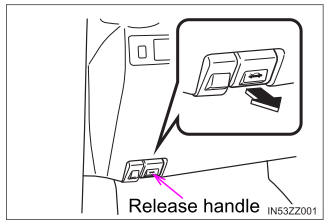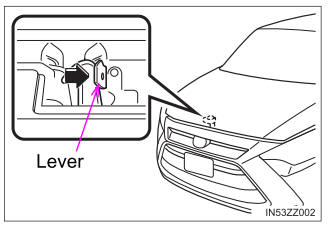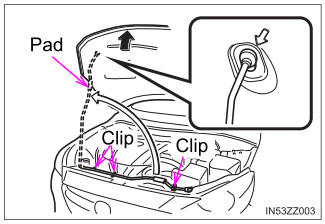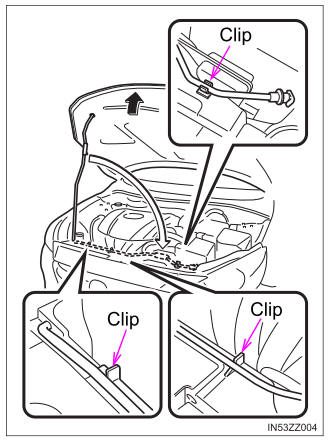Toyota Yaris: Owner Maintenance / Hood
- With the vehicle parked, pull the
release handle to unlock the
hood.

- Insert your hand into the hood
opening, slide the latch lever to
the right, and lift up the hood.

- Grasp the support rod in the
padded area and secure it in
the support rod hole indicated
by the arrow to hold the hood
open.

Closing the Hood
- Check under the hood area to make certain all filler caps are in place and all loose items (e.g. tools, oil containers, etc.) have been removed.
- Lift the hood, grasp the padded
area on the support rod, and
secure the support rod in the
clip. Verify that the support rod
is secured in the clip before
closing the hood.

- Lower the hood slowly to a height of about 7.9 in. (200 mm) above its closed position and then let it drop.
WARNING
Always check that the hood is closed and securely locked
A hood that is not closed and securely locked is dangerous as it could fly open while the vehicle is moving and block the driver’s vision which could result in a serious accident.
NOTICE
When closing the hood, do not push it excessively such as by applying your weight. Otherwise, the hood could be deformed.
 Owner Maintenance Precautions
Owner Maintenance Precautions
The owner or a qualified service technician should make these vehicle
inspections at the indicated intervals to ensure safe and dependable
operation...
Other information:
Toyota Yaris XP210 (2020-2025) Owner's Manual: Emergency Locking Mode
When the seat belt is fastened, it will always be in the emergency locking mode. In the emergency locking mode, the belt remains comfortable on the occupant and the retractor will lock in position during a collision. If the belt is locked and cannot be pulled out, retract the belt once, and then try pulling it out slowly...
Toyota Yaris XP210 (2020-2025) Reapir and Service Manual: Problem Symptoms Table
PROBLEM SYMPTOMS TABLE HINT: Use the table below to help determine the cause of problem symptoms. If multiple suspected areas are listed, the potential causes of the symptoms are listed in order of probability in the "Suspected Area" column of the table...
Categories
- Manuals Home
- Toyota Yaris Owners Manual
- Toyota Yaris Service Manual
- Power Integration No.1 System Missing Message (B235287,B235587,B235787-B235987)
- Engine Start Function When Key Battery is Dead
- Fuse Panel Description
- New on site
- Most important about car
Break-In Period
No special break-in is necessary, but a few precautions in the first 600 miles (1,000 km) may add to the performance, economy, and life of the vehicle.
Do not race the engine. Do not maintain one constant speed, either slow or fast, for a long period of time. Do not drive constantly at full-throttle or high engine rpm for extended periods of time. Avoid unnecessary hard stops. Avoid full-throttle starts.
Copyright © 2025 www.toyaris4.com

